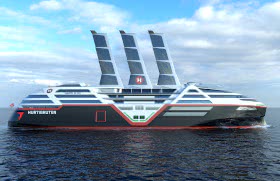
Today the Norwegian maritime group Hurtigruten presented the project for the construction of its first cruise ship in zero emissions that was announced over a year ago and that has now been more precisely defined by the consortium who works on the design study of which, in addition to Hurtigruten, 11 other companies are part including the shipbuilding company VARD of the Italian navalmeccanico group Fincantieri.
 The ship will be 135 meters long and can accommodate 500 passengers and 99 crew members and, while being dedicated Primarily to cruise activity, it will be equipped with also a large garage to embark cars. It's not However, the latter is the feature that will make the ship innovative in the cruise market, as the solutions for zero emissions. The first new naval unit, which According to forecasts it will be completed in 2030 and will be followed by other vessels of the same type, will be powered electrically and equipped with batteries that will be recharged in port. In addition, electricity will be combined with wind energy because, and this is the most innovative, it will be equipped with retractable sails, which will reach a maximum height of 50 meters when completely extended, on whose surfaces will be installed 1,5000 square meters of solar panels. In addition, the ship will have Automated manoeuvring, counter-rotating propellers and thrusters Retractable and other new technologies on board will include air lubrication and proactive hull cleaning.
The ship will be 135 meters long and can accommodate 500 passengers and 99 crew members and, while being dedicated Primarily to cruise activity, it will be equipped with also a large garage to embark cars. It's not However, the latter is the feature that will make the ship innovative in the cruise market, as the solutions for zero emissions. The first new naval unit, which According to forecasts it will be completed in 2030 and will be followed by other vessels of the same type, will be powered electrically and equipped with batteries that will be recharged in port. In addition, electricity will be combined with wind energy because, and this is the most innovative, it will be equipped with retractable sails, which will reach a maximum height of 50 meters when completely extended, on whose surfaces will be installed 1,5000 square meters of solar panels. In addition, the ship will have Automated manoeuvring, counter-rotating propellers and thrusters Retractable and other new technologies on board will include air lubrication and proactive hull cleaning.
Given the significant use of automated switching systems, A significant downsizing of the bridge is expected, which It will look more like the cockpit than a airplane. In anticipation of the use of the ship mainly along the Norwegian coast, which has been the main area for 130 years operational of the Hurtigruten group, the Norwegian company will collect data in the 34 ports in which it operates daily in order to increase the efficiency of maneuvers in port even in the event of adverse weather conditions.
"When we initially announced the Sea project. Zero" more than a year ago - explained Hedda Felin, managing director of Hurtigruten Norway, illustrating the path that led today to present the project - here we are Faced with the challenge of not knowing which technologies We could have availed ourselves in 2030. Our task was to open the road to innovation and improvement of existing technologies to align with our sustainability goals. Although Some of these technologies have reached a stage relatively advanced, however they still require research and Dedicated development to ensure a successful implementation in maritime context. On the other hand, some technologies are still in initial development phase and require basic research and testing deepened. After a rigorous feasibility study, we have identified the most promising technologies for our Revolutionary future cruise ships. We are committed to delivering A ship that within a few years surpasses all others in terms of energy efficiency and sustainability'.